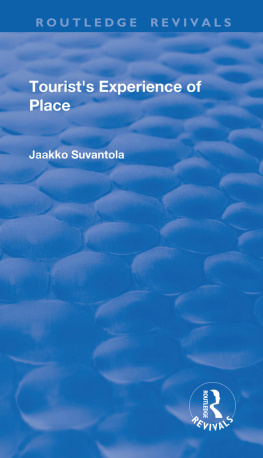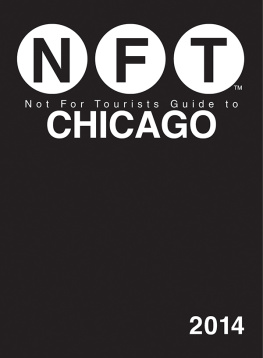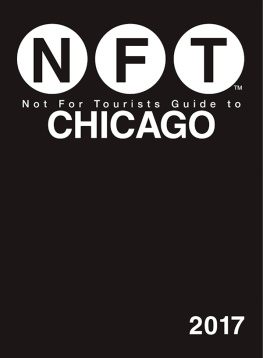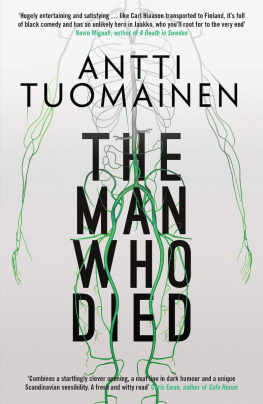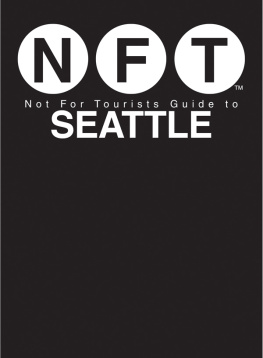TOURIST'S EXPERIENCE OF PLACE
New Directions in Tourism Analysis
Series Editors: Kevin Meethan, University of Plymouth Dimitri Ioannides, Southwest Missouri State University
Although tourism is becoming increasingly popular as both a taught subject and an area for empirical investigation, the theoretical underpinnings of many approaches have tended to be eclectic and somewhat underdeveloped. However, recent developments indicate that the field of tourism studies is beginning to develop in a more theoretically informed manner, but this has not yet been matched by current publications.
The aim of this series is to fill this gap with high quality monographs or edited collections that seek to develop tourism analysis at both theoretical and substantive levels using approaches which are broadly derived from allied social science disciplines such as Sociology, Social Anthropology, Human and Social Geography, and Cultural Studies. As tourism studies covers a wide range of activities and sub fields, certain areas such as Hospitality Management and Business, which are already well provided for, would be excluded. The series will therefore fill a gap in the current overall pattern of publication.
Suggested themes to be covered by the series, either singly or in combination, include-consumption; cultural change; development; gender; globalisation; political economy; social theory; sustainability.
Tourists Experience of Place
Jaakko Suvantola
First published 2002 by Ashgate Publishing
Reissued 2018 by Routledge
2 Park Square, Milton Park, Abingdon, Oxon OX14 4RN
711 Third Avenue, New York, NY 10017, USA
Routledge is an imprint of the Taylor & Francis Group, an informa business
Copyright Jaakko Suvantola 2002
The author has asserted his moral right under the Copyright, Designs and Patents Act, 1988, to be identified as the author of this work.
All rights reserved. No part of this book may be reprinted or reproduced or utilised in any form or by any electronic, mechanical, or other means, now known or hereafter invented, including photocopying and recording, or in any information storage or retrieval system, without permission in writing from the publishers.
Notice:
Product or corporate names may be trademarks or registered trademarks, and are used only for identification and explanation without intent to infringe.
Publishers Note
The publisher has gone to great lengths to ensure the quality of this reprint but points out that some imperfections in the original copies may be apparent.
Disclaimer
The publisher has made every effort to trace copyright holders and welcomes correspondence from those they have been unable to contact.
A Library of Congress record exists under LC control number: 2001097263
ISBN 13: 978-1-138-73837-9 (hbk)
ISBN 13: 978-1-315-18482-1 (ebk)
As an impressionable 22 year old I travelled around the world with a friend of mine. The early anthropologists like Malinowski and Mead, who travelled and stayed in the South Pacific, inspired us. We decided to spend a few months in Fiji and Samoa, to gain insight to the local culture, which was supposed to be well preserved. In the end we realised that we had learned a lot about life, people, and ourselves, but little about the people among whom we had spent those months. Since that trip I have been interested in how our experience of the Other takes place. Why did we learn so little about the Other people?
This work is an attempt to uncover some of the processes involved. It was submitted and accepted (after a round of revision) for the degree of PhD at the University of Adelaide in December 1997.
My endeavour to carry out this work would not have been possible without the funds provided by the Australian Government's Overseas Postgraduate Research Scholarship, and the University of Adelaide Scholarship. I was also greatly helped by the travel grant the University of Adelaide offered me.
I am indebted to my supervisor Peter Smailes, who guided me with patience. Apart from his considerable academic support, he also demonstrated genuine compassion in the moments of desperation. I am also grateful to Prof. Ian John and Dr. Petri Hottola for their useful comments and advice. Pertti Saarelainen did a great job of getting the layout in shape. Prof. Markku Tykkylinen, the head of our geography department here in Joensuu encouraged me to publish the book. The people who participated in my study gave me a lot to think about, and I warmly thank them for their co-operation. Of course, all shortcomings are my own.
I also want to thank my travel companion and friend from childhood, Marko Juntunen, who passed his enthusiasm to me. The biggest personal thanks I owe to my wife Leila, who has always cheered me in my pursuits. Finally, i want to acknowledge the impact of my parents Riitta and Vilho Suvantola, who always cultivated learning in me.
Joensuu, 28 May 2001 Jaakko Suvantola
In the academic study of tourism, the experience of tourists themselves has often had a small role. Even when it has been the object of the study, the focus has customarily been on marketing. However, the importance of travel experience can go far beyond mere consumption. As a geographer, I am particularly interested in travel experience as a change of place. In travel we are forced to pay attention to a new place. The experience there can reveal something about our relationship with places, and also about ourselves. What does it mean in the life of a tourist to experience a place?
Geography's contribution to the study of tourism has traditionally involved mainly environmental, regional, spatial, and evolutionary considerations (Mitchell and Murphy, 1991). The environmental considerations include for example the impact of tourism in the natural environment (Butler, 2000; Baldwin, 2000), Development of the orientation is the emergence of the study of eco-tourism from the end of the 80s (Draper and Kariel, 1990; Farrell and Runyan, 1991; Cater, 1993; Fennell, 1999). The regional orientation has appeared mainly as interest in tourism as a means of economic development (Hall, 1992; Milne, 1992; McCarthy, 1994; Walpole and Goodwin, 2000). The spatial orientation deals with spatial gravity models (Mansfeld, 1990; Meyer-Arendt, 1990) and the spatial perception of tourists. The latter has much in common with cognitive mapping, which features especially prominently in studies on the borderline of geography and psychology (Pearce, 1988; Walmsley and Jenkins, 1992). Finally, the evolutionary orientation emphasises the meanings of processes by which tourism trends and developments change through time, thus dealing with history of tourism developments (Demars, 1990; Hoffmann, 1992), their socio-cultural impacts (Toops, 1992; Hobbs, 1992), and evolutionary models such as the resort life-cycle (Butler, 1980; Cooper and Jackson, 1989; Gordon and Goodall, 2000; Johnston, 2001). Most recently, additional themes have come into focus: travel as consumption/production (Ateljevic, 2000) and travel and gender (Hottola, 1999; Pritchard and Morgan, 2000). From the traditional orientations, the behaviourist quest for explaining the development of tourists' cognition of the destination comes closest to understanding of the tourist's experience. However, the experience involves much more than just spatial cognition. The later themes of consumption and gender are more relevant in the context of personal experience. These must be taken into account in any attempt to understand a personal experience of travel.


